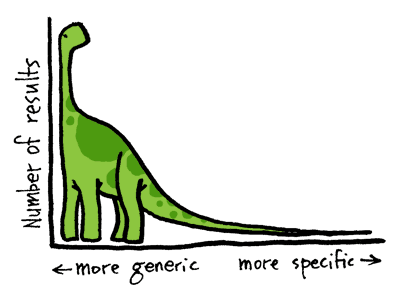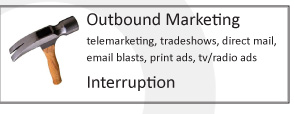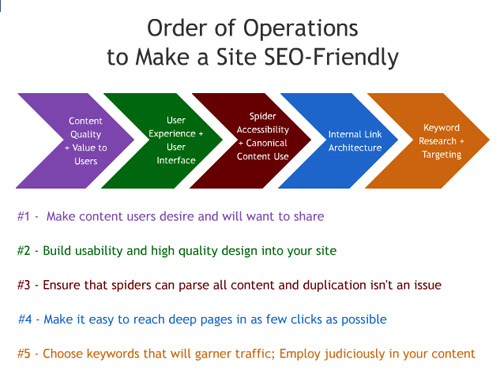 Do you need SEO or lead generation? We often have clients come to us asking for SEO when what they really want is lead generation. Many businesses and website designers get SEO and lead generation confused. Many think they are the same thing. They are not. Clients will often say, “if I can just get more visitors, I will sell more.” While this may be true to some extent, it’s not the most effective way to use a website.
Do you need SEO or lead generation? We often have clients come to us asking for SEO when what they really want is lead generation. Many businesses and website designers get SEO and lead generation confused. Many think they are the same thing. They are not. Clients will often say, “if I can just get more visitors, I will sell more.” While this may be true to some extent, it’s not the most effective way to use a website.
I believe this idea of more visitors equals more sales stems from old style interruption marketing. With interruption marketing, it is important to have a large audience because you are only going to gain the attention of a small percentage of that audience. You are interrupting what they are doing (watching TV, listening to the radio, reading a magazine, etc.), so you must distract them from that activity and get their attention focused on you.
With inbound (permission) marketing, you already have their attention, in fact, you have their permission. Visitors to your website are there because they were looking for your products or services. You don’t have to distract them from another activity. They are there because they chose to be. The question is “after visitors come to your website, what are you going to do with them?”
The answer should be, “turn them into customers or clients.” One of the most effective ways to do this is to first turn them into “leads”. Once they are leads, you can nurture them until they become customers or clients. In order for your website to be a serious lead generator, it must have the following:
- calls to action
- offers
- tracking codes
- a lead nurturing system
The best system we’ve found for lead generation is HubSpot software. We use it, and it has been very effective. So much so that we first became resellers for HubSpot and have now become certified HubSpot partners. HubSpot is an all in one marketing software that helps you attract visitors, turn them into leads and then nurture those leads. It helps you with your website, social media and blogging.
The folks at HubSpot are experts at inbound internet marketing, and they insisted that we be experts as well before we could be certified partners. There is no short-cut to becoming an expert. Believe me, we spend several hours a week on research and study to stay current and cutting edge to better help our clients as well as readers of this blog who come here to read our articles and get help with their internet marketing.
Key Take Away:
- While SEO is important in getting visitors to your website, it is just as important what you do with those visitors once they get there. SEO is a tactic while lead generation is a process.
- One of the best things you can do with website visitors is turn them into leads.
What to do next:
Interested in learning more about HubSpot software? Contact us to find out more. You can fill out the email form on the right or call us at 870.404.1985.
{ 0 comments }
 What are long tail keywords? They are the specific niche phrases that help you reach a very targeted market as opposed to short tail keywords that are targeted at a broader marketing. In 2010, on Google, over 50% of searches had over 4 keywords entered. Long tail keywords allow you to better reach your specific targeted audience. This image from the
What are long tail keywords? They are the specific niche phrases that help you reach a very targeted market as opposed to short tail keywords that are targeted at a broader marketing. In 2010, on Google, over 50% of searches had over 4 keywords entered. Long tail keywords allow you to better reach your specific targeted audience. This image from the  Should blogging be part of your SEO strategy? The short answer is “yes”. We’ve talked a lot about how the more content (i.e. pages) you have on the internet, the better your chance of showing up in search engine results. And there is no better way to put more targeted content on the web than by using targeted blog posts.
Should blogging be part of your SEO strategy? The short answer is “yes”. We’ve talked a lot about how the more content (i.e. pages) you have on the internet, the better your chance of showing up in search engine results. And there is no better way to put more targeted content on the web than by using targeted blog posts. Interruption marketing is more commonly known as advertising. It is where an advertiser finds an activity in which a large group of potential customers are participating (such as watching a TV show or listening to a radio station) and decides to interrupt (they call it sponsorship) that activity with their advertisement. They do this in the hope that someone who is participating in said activity will see or hear their advertisement and be enticed to buy their product or service.
Interruption marketing is more commonly known as advertising. It is where an advertiser finds an activity in which a large group of potential customers are participating (such as watching a TV show or listening to a radio station) and decides to interrupt (they call it sponsorship) that activity with their advertisement. They do this in the hope that someone who is participating in said activity will see or hear their advertisement and be enticed to buy their product or service. So today, SEO involves a lot more than just filling in the “keyword” meta-tag for your web pages. In fact, it doesn’t involve the “keyword” meta-tag at all. Today’s SEO is about “inbound” or permission marketing. You must provide relevant content on your website and social media sites. This content will serve as a magnet to potential customers who are searching for what you have to offer. Don’t bait and switch. Present yourself as an expert in your field. Start a blog.
So today, SEO involves a lot more than just filling in the “keyword” meta-tag for your web pages. In fact, it doesn’t involve the “keyword” meta-tag at all. Today’s SEO is about “inbound” or permission marketing. You must provide relevant content on your website and social media sites. This content will serve as a magnet to potential customers who are searching for what you have to offer. Don’t bait and switch. Present yourself as an expert in your field. Start a blog.


 The line between SEO and Social Media is becoming more blurred all the time, especially with the socialization of Google (discussed in our previous post
The line between SEO and Social Media is becoming more blurred all the time, especially with the socialization of Google (discussed in our previous post 
 In the next couple of weeks, this blog will be discussing SEO (search engine optimization). Today, lets look at Facebook SEO Strategies.
In the next couple of weeks, this blog will be discussing SEO (search engine optimization). Today, lets look at Facebook SEO Strategies.